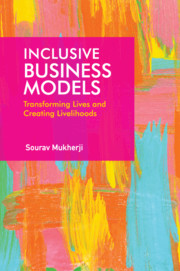Book contents
- Frontmatter
- Dedication
- Contents
- List of Tables
- List of Figures
- Preface
- Acknowledgements
- 1 Introduction
- 2 Vaatsalya Hospitals: Affordable Healthcare in Proximity
- 3 Gyan Shala: Providing Inclusive Education
- 4 Rang De: Creating a Platform for Social Investing
- 5 Labournet: Empowering Informal Sector Labourers
- 6 Selco: Inclusive Model for Energy Access
- 7 Hasiru Dala Innovations: Improving Lives of Waste Pickers
- 8 Reliance Retail: Creating Inclusive Supply Chain
- 9 International Development Enterprise (Ide) Nepal: Developing Smallholder Ecosystem
- 10 Ruralshores: Delivering Inclusive Service
- 11 Gujarat Narmada Fertilizer Company’s (Gnfc) Neem Initiative: A Social Business
- 12 Bringing it All Together
- References
- Index
Preface
Published online by Cambridge University Press: 31 July 2021
- Frontmatter
- Dedication
- Contents
- List of Tables
- List of Figures
- Preface
- Acknowledgements
- 1 Introduction
- 2 Vaatsalya Hospitals: Affordable Healthcare in Proximity
- 3 Gyan Shala: Providing Inclusive Education
- 4 Rang De: Creating a Platform for Social Investing
- 5 Labournet: Empowering Informal Sector Labourers
- 6 Selco: Inclusive Model for Energy Access
- 7 Hasiru Dala Innovations: Improving Lives of Waste Pickers
- 8 Reliance Retail: Creating Inclusive Supply Chain
- 9 International Development Enterprise (Ide) Nepal: Developing Smallholder Ecosystem
- 10 Ruralshores: Delivering Inclusive Service
- 11 Gujarat Narmada Fertilizer Company’s (Gnfc) Neem Initiative: A Social Business
- 12 Bringing it All Together
- References
- Index
Summary
Harish Hande, the founder of SELCO, was my senior at Indian Institute of Technology (IIT) Kharagpur. Our paths crossed a decade later when I learnt that Harish, having completed his PhD, was building an organization that would provide solar lights to poor villagers in his home state of Karnataka. I travelled with him in upcountry Karnataka and saw first-hand how the lack of access to energy created challenges in the lives of villagers and how the work that Harish was planning to do was a lifesaver for them. Having grown up in a town and later staying in a city, I had little familiarity with the life in villages. I had never seen as much darkness in my life as I witnessed in those villages at night. Harish was lighting up their lives. I came back awestruck and inspired. But I did not fully comprehend what Harish meant when he said he would create a business where he would sell solar lights to the villagers. Looking at their economic conditions, I could not imagine how the villagers were going to pay Harish. Should he not raise funds from charitable institutions and just donate these lights, I wondered.
After I joined Indian Institute of Management (IIM) Bangalore as a faculty member, I focused on researching about Indian multinationals competing in international markets. While I continued to follow Harish's and SELCO's journey with admiration, it was quite distant from what I was teaching and researching as an academician. Around 2007, at an international conference in Bratislava, I met Sahba Sobhani from the United Nations Development Programme (UNDP) who explained to me the concept of inclusive markets and gave the example of SELCO. Sahba was looking for academics who could write case studies on organizations that created inclusive business models. Suddenly, I remembered what Harish had tried to explain to me almost a decade ago – how it was possible to address the needs of the poor by building a financially sustainable business – and things started to make sense.
I told Sahba that I would write a case on SELCO and I started my research in this domain.
- Type
- Chapter
- Information
- Inclusive Business ModelsTransforming Lives and Creating Livelihoods, pp. xiii - xviPublisher: Cambridge University PressPrint publication year: 2021

